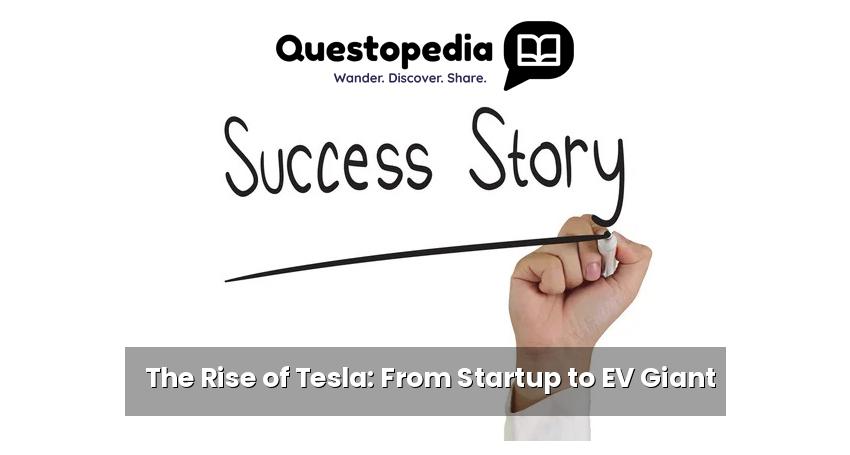The Rise of Tesla: From Startup to EV Giant
From a struggling Silicon Valley startup to the undisputed leader in the electric vehicle (EV) market, Tesla’s journey is a testament to innovation, ambition, and a relentless pursuit of a sustainable future. This article explores the key milestones, challenges, and triumphs that have shaped Tesla’s rise, examining how it disrupted the automotive industry and paved the way for the electric revolution.
The Early Days: Building a Vision (and a Roadster)
Founded in 2003 by Martin Eberhard and Marc Tarpenning, the company, initially named Tesla Motors, aimed to prove that electric cars could be better, quicker, and more fun to drive than gasoline cars. However, it was Elon Musk, who joined the company as Chairman and product architect in 2004, who truly propelled the vision forward. His ambitious goals extended beyond just creating electric cars; he envisioned a world powered by sustainable energy. The first fruit of this vision was the Tesla Roadster, a high-performance sports car that shattered preconceived notions about electric vehicles. While plagued with production delays and financial difficulties, the Roadster proved the concept and generated significant buzz.
The challenges were immense. Battery technology was still in its infancy, charging infrastructure was virtually nonexistent, and traditional automakers viewed electric cars as a niche market. Tesla faced skepticism from all sides, but Musk’s unwavering belief in the company’s mission kept the project alive. You can visit Questopedia for more information about the early startup era.
Scaling Up: The Model S and Mass Market Ambitions
The launch of the Model S in 2012 marked a turning point for Tesla. This luxury sedan combined stunning performance, a long driving range, and cutting-edge technology, appealing to a wider audience than the Roadster ever could. The Model S received rave reviews and quickly became a symbol of innovation and luxury. Crucially, it validated Tesla’s business model and demonstrated that electric cars could be both desirable and practical.
Building the Model S was a monumental undertaking. Tesla had to develop its own battery technology, build a global charging network (Supercharger network), and establish a manufacturing facility capable of producing cars at scale. This required massive investment and a significant amount of risk-taking. Musk’s ability to secure funding and his hands-on approach to engineering and manufacturing were crucial to the Model S’s success.
Production bottlenecks and quality control issues were persistent challenges during this phase. Tesla had to overcome these hurdles to maintain its reputation and meet the growing demand for its vehicles. To read more about Model S and its features, visit Tesla Model S official website.
Expanding the Lineup: Model X, Model 3, and Beyond
Following the success of the Model S, Tesla expanded its product lineup with the Model X SUV in 2015. While the Model X introduced unique features like falcon wing doors, it also faced production challenges and reliability issues. However, the introduction of the Model 3 in 2017 was a game-changer. Designed as a mass-market electric car, the Model 3 made electric vehicles accessible to a much broader audience. Pre-orders for the Model 3 exceeded expectations, creating a massive backlog and putting enormous pressure on Tesla’s production capacity.
The Model 3 ramp-up was a period of intense struggle. Tesla faced significant “production hell,” battling bottlenecks, quality issues, and financial strain. Musk famously slept on the factory floor to personally oversee the production process. Despite the challenges, Tesla eventually managed to overcome these obstacles and ramp up Model 3 production, solidifying its position as the leader in the EV market.
The addition of the Model Y, a compact SUV, further expanded Tesla’s reach and cemented its dominance in the EV space. Tesla has also ventured into other areas, including energy storage (Powerwall and Megapack) and solar energy, further diversifying its business and contributing to its sustainable energy mission. This expansion is also described in a Reuters article about Tesla’s Revenue
Key Factors in Tesla’s Success
Several key factors have contributed to Tesla’s remarkable success:
- Innovation: Tesla has consistently pushed the boundaries of EV technology, developing its own battery technology, autonomous driving capabilities, and over-the-air software updates.
- Brand Image: Tesla has cultivated a strong brand image associated with innovation, sustainability, and luxury.
- Supercharger Network: Tesla’s extensive Supercharger network provides convenient and reliable charging for its customers, addressing a key concern for EV buyers.
- Elon Musk’s Leadership: Musk’s vision, ambition, and relentless pursuit of innovation have been instrumental in driving Tesla’s success.
- Direct-to-Consumer Sales: Tesla’s direct-to-consumer sales model allows it to control the customer experience and avoid the limitations of traditional dealership networks.
Challenges and Future Outlook
Despite its impressive growth, Tesla faces significant challenges, including increasing competition from established automakers, supply chain disruptions, regulatory scrutiny, and concerns about its manufacturing processes. Scaling production to meet global demand while maintaining quality control remains a critical challenge.
The future of Tesla is uncertain, but the company is well-positioned to continue leading the electric vehicle revolution. Tesla’s continued investment in battery technology, autonomous driving, and energy storage positions it as a key player in the future of sustainable transportation and energy. As competition intensifies, Tesla will need to continue innovating and adapting to maintain its leadership position.
Conclusion
Tesla’s journey from a struggling startup to an EV giant is a remarkable story of innovation, ambition, and perseverance. The company has fundamentally changed the automotive industry and accelerated the transition to electric vehicles. While challenges remain, Tesla’s success has inspired other automakers to invest in EVs and has paved the way for a more sustainable future. The rise of Tesla as an EV giant shows the power of technological innovation and the entrepreneurial spirit to overcome barriers and make a significant difference in the world. Consider visiting Questopedia for more articles about innovative companies.






